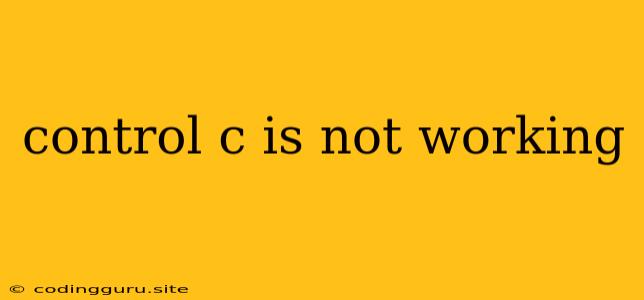"Control C" Not Working: Troubleshooting Keyboard Issues
Have you ever found yourself stuck in a command line interface (CLI) or application, unable to stop it with the usual Control + C shortcut? It's a frustrating experience, especially when you need to exit a program quickly or terminate a process that's gone haywire. This article will guide you through various troubleshooting steps to fix this common problem.
Understanding the Issue
Control + C is a standard keyboard shortcut used to interrupt running processes and send an "Interrupt" signal to the operating system. When this combination doesn't work, it usually indicates an issue with either your keyboard, the terminal emulator, or the program itself.
Possible Causes
1. Keyboard Hardware Issues:
- Faulty Keys: The Control or C key might be physically damaged or have a sticky key issue. Try cleaning the keys with compressed air or a soft cloth to remove any debris.
- Incorrect Key Binding: Some keyboards might have custom key bindings that override the default Control + C function. Check your keyboard settings or manual for any adjustments.
2. Terminal Emulator Settings:
- Disabled Interrupt Handling: Your terminal emulator might have an option to disable or change the interrupt signal handling. Look for settings related to "Interrupt", "Signal Handling", or "Keyboard Shortcuts".
- Configuration Errors: Sometimes, the terminal emulator's configuration file might contain errors that prevent Control + C from working correctly.
3. Program Specific Issues:
- Ignoring Interrupts: Some programs are designed to ignore or delay interruption signals.
- Infinite Loops: If the program is stuck in an infinite loop, it might not respond to the Control + C signal.
Troubleshooting Steps
1. Basic Checks:
- Restart your computer: This might fix temporary glitches or conflicts that might be preventing Control + C from working.
- Check the keyboard: Make sure the Control and C keys are clean and responsive. Try using a different keyboard if available.
- Try a different terminal emulator: If you're using a specific terminal emulator, try switching to a different one like xterm, konsole, or Putty to see if the problem persists.
2. Terminal Emulator Settings:
- Enable Interrupt Handling: If it's disabled, enable it in your terminal emulator's settings.
- Reset Configuration: Resetting the terminal emulator's configuration to default might fix any errors or overrides.
3. Program Specific Solutions:
- Check documentation: Consult the program's documentation for alternative ways to exit or interrupt the process. Some programs might have their own specific command line options.
- Force termination: If the program is completely unresponsive, you can try forcibly terminating it using a command line tool like "kill" or "pkill".
4. Other Solutions:
- Reinstall the terminal emulator: If you suspect a corrupted installation, reinstalling the terminal emulator might resolve the issue.
- Update your operating system: An outdated operating system might have compatibility issues with certain programs or terminal emulators.
Examples
Example 1: Forcefully terminating a process using the "kill" command:
kill -9
Example 2: Resetting the configuration of a terminal emulator (Bash):
rm ~/.bashrc
Example 3: Disabling a custom key binding in a terminal emulator:
# This will disable a custom key binding for Control + C. This command might vary depending on the terminal emulator.
bind -x "C-c"
Conclusion
Troubleshooting a broken Control + C shortcut can be tricky, but by systematically checking the keyboard, terminal emulator settings, and program-specific behaviors, you can usually identify and fix the root cause. Remember, patience and careful investigation are key to resolving this common technical issue.
